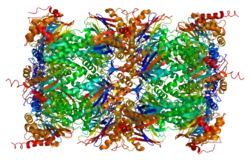| Threonine Protease | |||||||
|---|---|---|---|---|---|---|---|
 Crystal structure of human proteasome alpha 1 | |||||||
| Identifiers | |||||||
| Symbol | Thr | ||||||
| |||||||
Threonine proteases are a family of proteolytic enzymes harbouring a threonine (Thr) residue within the active site. The prototype members of this class of enzymes are the catalytic subunits of the proteasome, however, the acyltransferases convergently evolved the same active site geometry and mechanism.
Mechanism
Threonine proteases use the secondary alcohol of their N-terminal threonine as a nucleophile to perform catalysis.[1][2] The threonine must be N-terminal since the terminal amine of the same residue acts as a general base by polarising an ordered water which deprotonates the alcohol to increase its reactivity as a nucleophile.[3][4]
Catalysis takes place in two steps:
- Firstly the nucleophile attacks the substrate to form a covalent acyl-enzyme intermediate, releasing the first product.
- Secondly the intermediate is hydrolysed by water to regenerate the free enzyme and release the second product.
- In ornithine acyltransferase, instead of water, the substrate ornithine (the acceptor) performs the second nucleophilic attack and so leaves with the acyl group.
Classification and evolution

Five families belonging to two separate superfamilies are currently recognised: the Ntn fold proteosomes[1] (superfamily PB) and the DOM fold ornithine acyltransferases[2] (superfamily PE). The two superfamilies represent two independent, convergent evolutions of the same active site.[4][5]
| Superfamily | Threonine protease families | Examples |
|---|---|---|
| PB clan | T1, T2, T3, T6 | archaean proteasome, beta component (Thermoplasma acidophilum) |
| PE clan | T5 | ornithine acetyltransferase (Saccharomyces cerevisiae) |
See also
- Protease
- Enzyme
- Proteolysis
- Catalytic triad
- Convergent evolution
- The Proteolysis Map
- Protease inhibitor (pharmacology)
- Protease inhibitor (biology)
- TopFIND - database of protease specificity, substrates, products and inhibitors
- MEROPS - database of protease evolutionary groups
References
- 1 2 Brannigan JA, Dodson G, Duggleby HJ, Moody PC, Smith JL, Tomchick DR, Murzin AG (November 1995). "A protein catalytic framework with an N-terminal nucleophile is capable of self-activation". Nature. 378 (6555): 416–9. Bibcode:1995Natur.378..416B. doi:10.1038/378416a0. PMID 7477383. S2CID 4277904.
- 1 2 Cheng H, Grishin NV (July 2005). "DOM-fold: a structure with crossing loops found in DmpA, ornithine acetyltransferase, and molybdenum cofactor-binding domain". Protein Science. 14 (7): 1902–10. doi:10.1110/ps.051364905. PMC 2253344. PMID 15937278.
- ↑ Dodson G, Wlodawer A (September 1998). "Catalytic triads and their relatives". Trends in Biochemical Sciences. 23 (9): 347–52. doi:10.1016/S0968-0004(98)01254-7. PMID 9787641.
- 1 2 Ekici OD, Paetzel M, Dalbey RE (December 2008). "Unconventional serine proteases: variations on the catalytic Ser/His/Asp triad configuration". Protein Science. 17 (12): 2023–37. doi:10.1110/ps.035436.108. PMC 2590910. PMID 18824507.
- ↑ Buller AR, Townsend CA (February 2013). "Intrinsic evolutionary constraints on protease structure, enzyme acylation, and the identity of the catalytic triad". Proceedings of the National Academy of Sciences of the United States of America. 110 (8): E653-61. doi:10.1073/pnas.1221050110. PMC 3581919. PMID 23382230.